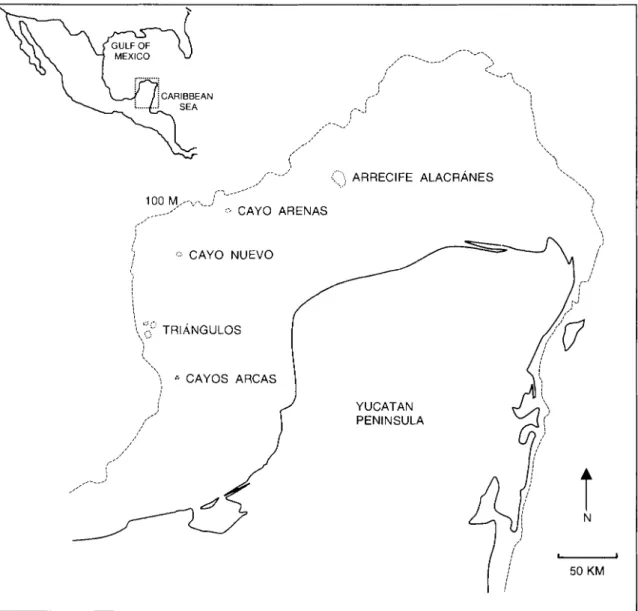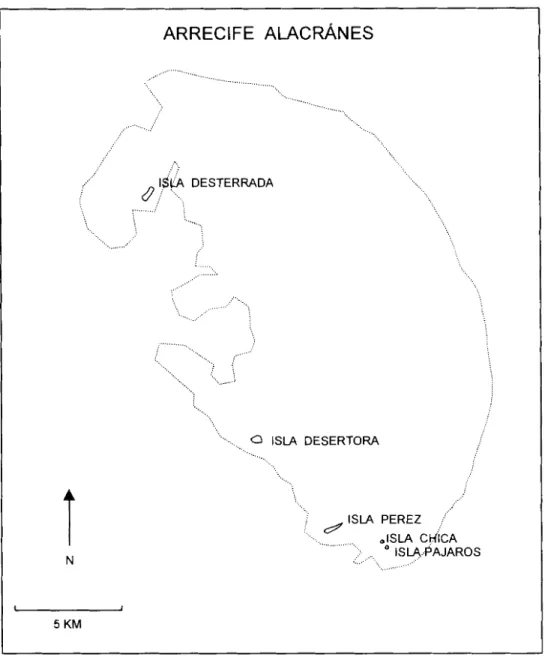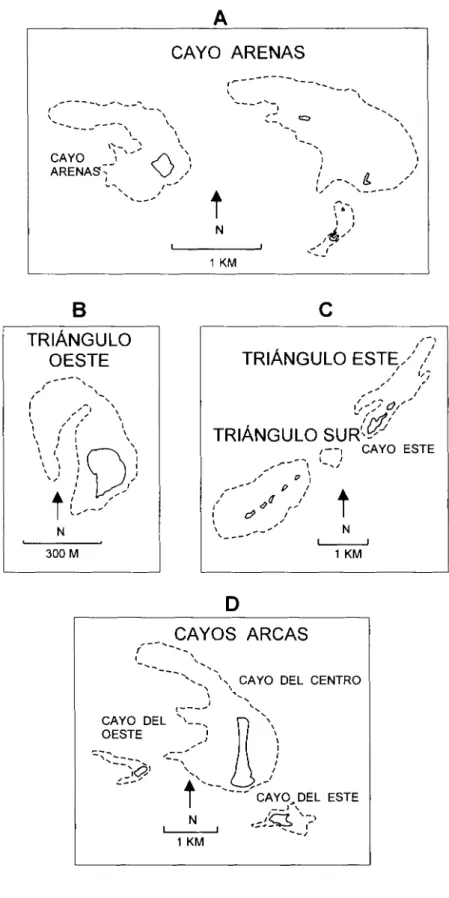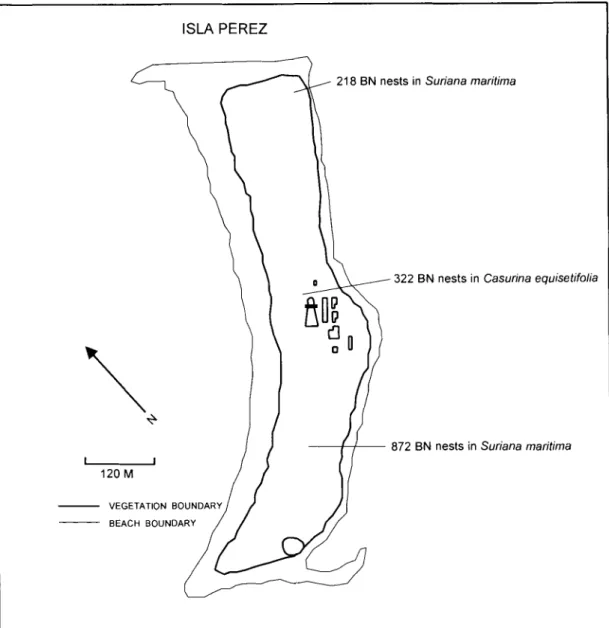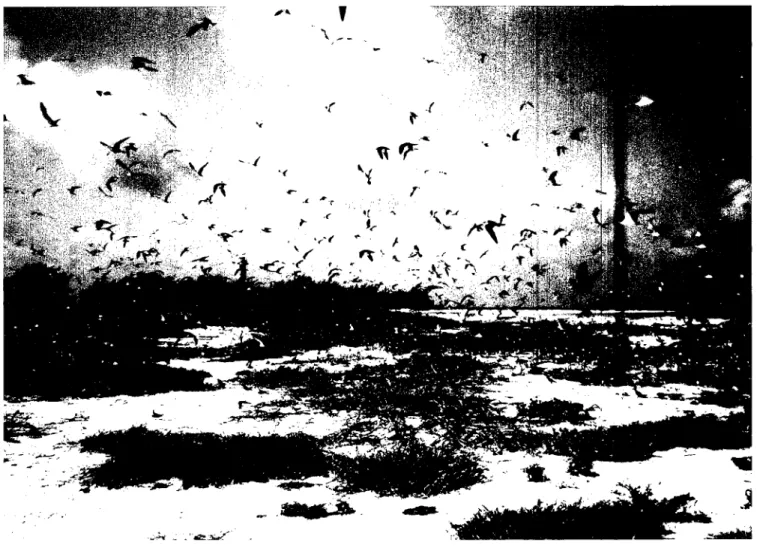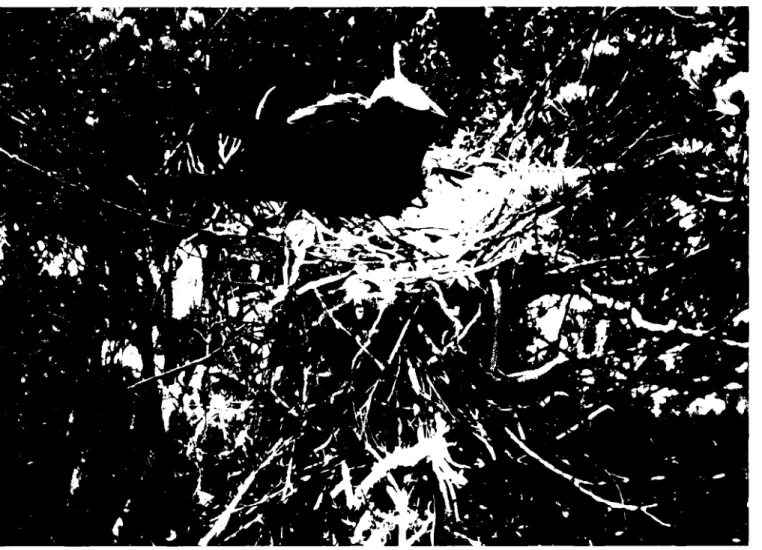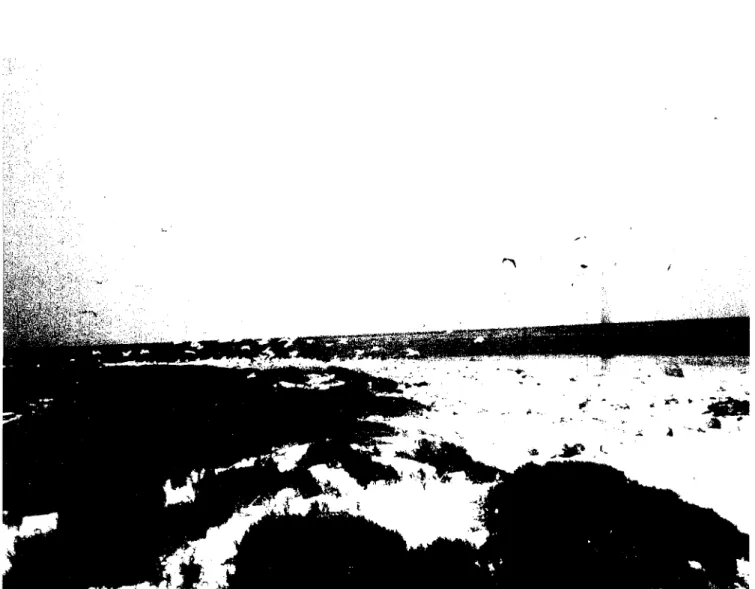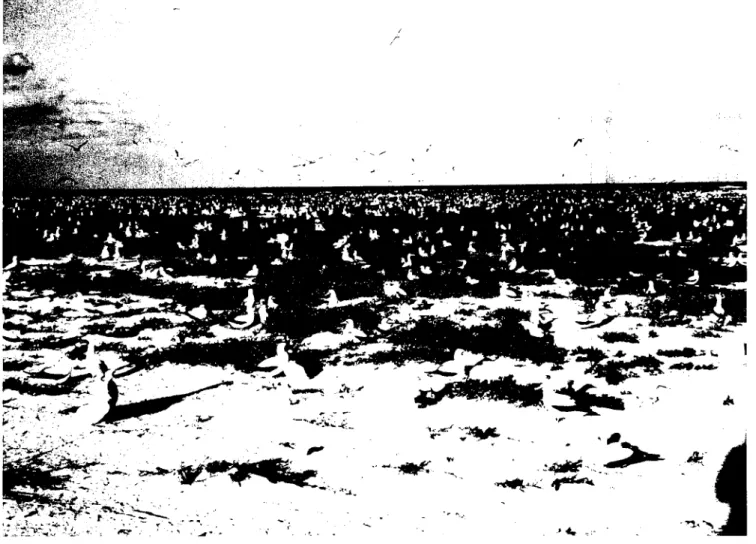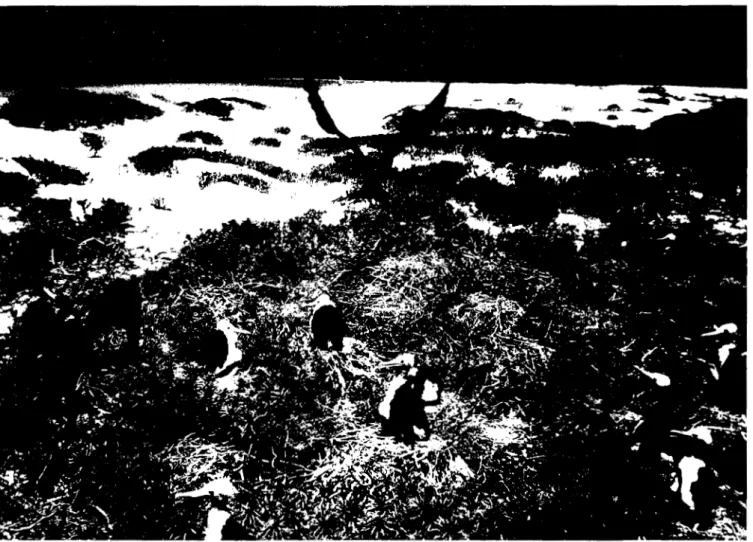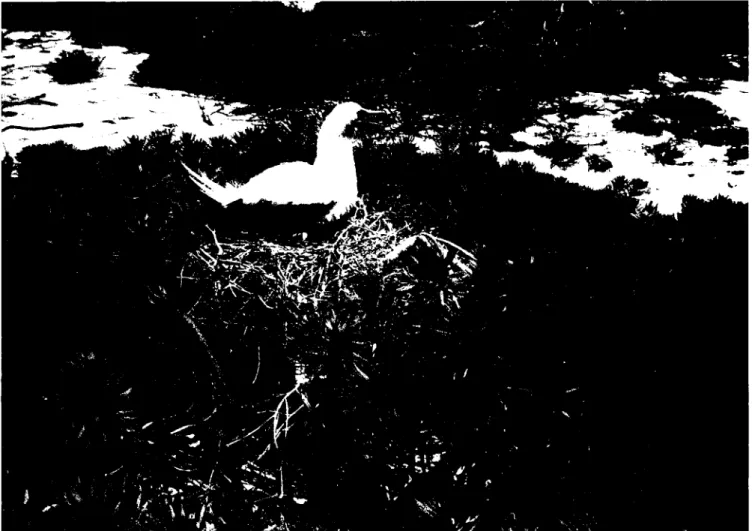ATOLL RESEARCH BULLETIN NO. 482
SEABIRDS OF THE CAMPECHE BANK ISLANDS, SOUTHEASTERN GULF OF MEXICO
BY
JOHN W. TUNNELL AND BRIAN R. CHAPMAN
ISSUED BY
NATIONAL MUSEUM OF NATURAL HISTORY SMITHSONIAN INSTITUTION
WASHINGTON, D.C., U.S.A.
JUNE 2000
Figure 1. Location of reef island complexes on the Campeche Bank of the southeastern Gulf of Mexico.
SEABIRDS OF THE CAMPECHE BANK ISLANDS, SOUTHEASTERN GULF OF MEXICO
JOHN W. TUNNELL, JR.' and BRIAN R.
CHAP MAN^
ABSTRACT
Seabirds of the Campeche Bank islands in the Gulf of Mexico were surveyed during 1986. Eight of 12 permanently emergent islands had active seabird nesting colonies during the study period from winter through summer. Nine species of colonial seabirds nested on the islands: Masked Booby, Brown Booby, Red-footed Booby, Magnificent Frigatebird, Laughing Gull, Royal Tern, Sandwich Tern, Sooty Tern, and Brown Noddy. Descriptions of colony locations in relation to vegetation or other island features along with bird censuses and historical records are presented. These large seabird populations in the southern Gulf of Mexico appear to have remained fairly stable, and they should be surveyed on a regular basis and protected.
INTRODUCTION
The Campeche Bank, an extensive submarine continuation of the limestone plateau that forms the Yucatan Peninsula (Macintyre et al. 1977), extends for about 650 km along the western and northern coasts of the Yucath in the southeastern Gulf of Mexico. The bank is characterized by relatively shallow waters with many shoals and coral reefs, but few emergent islands. Within the Campeche Bank there are only four groups of islands (Figure 1) that are large enough and sufficiently elevated to support terrestrial floras and faunas.
These groups are known as Arrecife Alacranes (22" 23' N, 89" 40' W), Cayo Arenas (22" 07' N, 91" 24' W), Arrecifes Triangulos (20" 58' N, 92' 20' W), and Cayos Arcas (20' 13' N, 91"
58' W). A fifth, Cayo Nuevo (21" 50' N, 92" 04' W), consists of a low, barren sand cay that probably is inundated by storm tides and wave action and a submergent reef flat that may be exposed during extremely low tides. All of the islands in these groups are located more than 120 km from the mainland and rarely are visited by recreational boaters or fishermen, although considerable numbers of commercial fishermen regularly visit some of the islands, primarily the Alacrhes and Arenas groups. All four of the main island groups have lighthouses that are staffed by keepers, and sometimes their families and pets. Some of the islands (Arcas group) also facilitate crude oil storage and transfer facilities by Petroleos Mexicanos (PEMEX), the national oil company of Mexico, and are guarded by small (2-4 men) Naval detachments. Each island group has a Naval weather station.
'
Center for Coastal Studies, Texas A&M University-
Corpus Christi, 6300 Ocean Dr., Corpus Christi, TX, 78412, USA.College of Arts and Sciences, Sam Houston State University, Box 2209, Huntsville, TX 77341 -2209, USA.
Manuscript received 19 July 1999; revised 1 May 2000
Geologic and topographic features (Kornicker et al. 1959, Fosberg I96 1, Folk 1967, Macintyre et al. 1977, Wells 1988), submarine fauna (Kornicker et al. 1959, Kornicker and Boyd 1962, Farrell et al. 1983, Chavez et al. 1985) and terrestrial flora (Millspaugh 191 6, Bonet and Rzedowski 1962) of certain Campeche Bank islands have been described, but terrestrial fauna of the islands has not been well documented. Much of the information about seabirds that visit or nest on the Campeche Bank islands must be gleaned from anecdotal accounts in cruise reports, geologic explorations, or floristic surveys.
Although there have been several recent accounts of marine birds on the Campeche Bank reefs (Paynter 1955, Boswall 1978, Tunnel1 and Chapman 1988, Howell 1989, Lockwood 1989), thorough surveys of the seabird populations apparently have never been made during the probable period of peak nesting (Clapp et al. 1982).
The first account of the seabird colonies on the Campeche Bank islands was written by the English adventurer Dampier (1 699), who first visited the area in 1675. Nearly two centuries passed before the avifauna of the islands north of the Yucathn Peninsula was again mentioned by Smith (1 838), Marion (1 884), Ward (1 887) and Agassiz (1 888). A British Navy officer visited two of the smaller islands in Alacrhn Reef (islas Pajaros and Chica) in mid-May 191 2, and provided the first indication that the Campeche Bank islands might be significant nesting areas for tropical terns (Kennedy 191 7). However, these early accounts were based upon brief visits to one or two islands of a single reef and the avifauna of the islands remained poorly documented until the early 1950's.
During a survey of the birds of the Yucath Peninsula, Paynter (1 955) landed on four islands in 1952 and became the first scientist to describe the colonies of marine birds on more than one of the reef complexes. Although his visits to the islands were made during August and September, probably too late to observe the peak of nesting, Paynter found a few active nests of some species and speculated upon the extent of the colonies. Large flocks of many species remained in the area and the remnants of recently abandoned nests were evident. Interestingly, both Paynter (1 953,1955) and Siebenaler (1 954) visited or anchored near several of the Campeche Bank islands in August and September, 1952, but Seibenaler did not mention the presence of nesting seabirds or the existence of seabird nests. Both of these researchers were recording the presence of avian species engaged in trans-Gulf migration.
Kornicker et al. (1959) were on Alacran Reef in June 1959, but focused their attention on the marine features of the reef. They listed the birds that were seen nesting on the islands without providing information on avian numbers or colony locations. A l a c r h Reef was examined again in August and September 1975 by Boswall (1978), who summarized most of the published information on the marine birds of the reef.
The IXTOC I oil spill in the Bay of Campeche focused renewed attention on the seabird colonies in the southern Gulf of Mexico. The spill, which began on 3 June 1979, occurred when an offshore drilling rig blew out at a location just 75 km from a known seabird colony on Cayos Arcas (Clapp et al. 1982). Oil from IXTOC I flowed continuously until March 1980, and an estimated 3.3 billion barrels of oil were released into the Gulf of Mexico (Woods and Hannah 198 1 ). Although few oiled seabirds were recovered along the
Texas coast after the spill (Chapman 1981), the islands of the Campeche Bank were apparently never checked while oil was contaminating the waters of the Gulf (Clapp et al.
1982). The probability was high that many nesting birds were oiled because of the timing of the spill. Duncan and Havard (1 980) determined that many species of pelagic birds regularly frequent the northern Gulf of Mexico, an area that was heavily impacted by the spill.
Consequently, Clapp et al. (1 982) urged that seabird populations in the Gulf of Mexico be surveyed.
Between January and July 1986, one of us (JWT) visited all four coral reef complexes, including 12 islands, on the Campeche Bank. Since some of the islands were visited during the probable peak of the seabird breeding season, we censused the nesting birds on each island and surveyed their colony locations relative to vegetative and topographic features. Although our visits to some islands likely did not coincide with the peak of the nesting season, we are providing the most comprehensive description of the avifauna on the Campeche Bank islands available to date. We suggest that colonies of nesting seabirds are much larger and more widely dispersed among the islands than previously believed. Furthermore, since Alacrh was recently designated as a protected area (Parque Marino Nacional Arrecife Alacranes) and the other Campeche Bank islands are under consideration for protection, we recommend monitoring and conservation programs be developed to sustain these populations as some of the most extensive seabird nesting colonies in the Gulf of Mexico.
STUDY AREA
The Campeche Bank extends seaward into the Gulf of Mexico 190 to 290 krn beyond the northern shoreline of the Yucatan Peninsula. The continental shelf slopes gently from the shoreline to the shelf-slope edge at an overall gradient of approximately 0.5 m per krn.
The submerged plateau is bordered on the west, north and east by steep slopes which drop from depths of 80-220 m at the shelf-slope edge to the abyssal zones of the Gulf of Mexico.
Three major submerged terraces are superimposed upon the bank and occur at depths of 90- 1 10 m, 50-64 m, and 30-37 m (Logan 1962, 1969). A succession of rocky knolls are aligned along the shallowest portions of the 50-64 m terrace and form an almost continuous raised rim around the western and northern margins of the Campeche Bank. Although most of these knolls form topographic highs reaching elevations of 15-45 m below present sea levels, communities of hermatypic corals, encrusting and nodule-forming coralline algae and foraminifera colonize the flanks of some knolls, raising reefs and reef-banks to the surface.
Four of these coral reef complexes have low islands (cays) of coral rubble or sand on their tops. These reef complexes consist of 15 permanently emergent islands, 12 of which are vegetated.
The island-reef complexes of the Campeche Bank consist of low islands encircled by shallow-water sand flats, seagrass meadows and reef flats. The reefs are surrounded by clear, tropical oceanic water that flows from the Caribbean Sea into the Gulf of Mkxico.
Currents generally run from the east or northeast at all Campeche Bank reef complexes, but during the period from November to February, "nortes" (winter cold fronts) occasionally reach the area and generate strong winds, wave energy and surface currents from the north.
During most of the year, the prevailing winds are easterly, varying from northeast to southeast, and tidal ranges are minimal, fluctuating from 0.6m to 1.0 m (Wells 1988).
Surface water temperatures in the area range from 29' to 30' C during the summer to a minimum of 24' C in the winter (Logan 1969). Brief descriptions of each reef-island complex and their habitats are given below.
Arrecife Alacranes
Alacran Reef is the largest (25 x 13 km) and most well known of the Carnpeche Bank reef formations (Kornicker et al. 1959, Fosberg 1962, Kornicker and Boyd 1962, Hoskin 1963, 1966, Bonet 1967, Folk 1967, Chavez et al. 1985, Wells 1988). The Alacrh atoll platform, located approximately 137 km north of Progreso, Yucatan, has five sand cays on its leeward margin (Figure 2). All of the islands are low-lying and their outlines vary seasonally with storms and changing wind directions (Kornicker et al. 1959). The cays support abundant vegetation (Millspaugh 19 16, Bonet and Rzedowski 1962, Fosberg 1962) and seabird nesting colonies (Boswall 1978). The larger islands, islas Perez, Desertora, and Desterrada, are situated on the leeward shelf of the reef, whereas islas Chica and Pajaros are located on the southern tip of the inner reef flat. Isla Desterrada was once cut apart by a storm to form islets, East and West Desterrada (Fosberg 1962), that have since rejoined. A sand bar, called Desaparecida Bar, usually is emergent on the middle part of the leeward reef shelf during the summer months, but is eroded by wave action and disappears with the onset of northerly winds. Isla Perez, the largest of the cays (1 50 m x 870 m), is the only island on Alacran Reef that has been altered by human activity. The island has a manned lighthouse and weather station and several abandoned buildings that are occasionally occupied by visiting fishermen. Isla Desterrada has an automated light. Some of the islands have local names (in parenthesis) that may cause confusion because they appear in some earlier reports:
Desterrada (Utowane); Desertora (Allison; Muertos); and Pajaros (Blanca).
Cayo Arenas
Three reef masses on the northern margin of the continental shelf form the Arenas reef group which consists of four emergent islands (Logan 1969). Three of the emergent islands on this reef are unnamed (Figure 3A). These islands are small, unvegetated and composed primarily of coral rubble (Chavez et al. 1985). Only one island on this reef, Cayo Arenas, is large and elevated enough to support permanent vegetation. The island, which measures 240 m x 275 m across its widest points, is composed of sand in the central and leeward (westward) portions, but the substrate on windward side is mostly coral rubble and solidified beachrock (Busby 1966). A manned lighthouse and weather station are centrally located.
Cayo Nuevo
Nuevo reef is a small reef knoll located on the northwestern margin of the Yucathn shelf (Logan 1969). Cayo Nuevo is a small, crescent-shaped sandy island that sits atop a limestone prominence. The cay remains barren because it is frequently inundated by storm
. . . . . .
l&A DESTERRADA
...
8
;a ISLA DESERTORA ...
...
::,
'9' lSlA PEREZ I"... o~~~~ CMICA
> . . . .. O 1SLA:I'AJAROS
; ...
... ...
Figure 2. Map of Arrecife Alacranes (Alacran atoll) showing reef islands on leeward margin.
waves and abnormally high tides. The low-lying island may serve as a roosting and loafing area for birds, but it may be too ephemeral to serve as a nesting area.
Arrecifes Triangulos
The Triangulos reef group is the smallest and least known of the four major Carnpeche Bank reef-island formations (Chavez 1966, Logan 1969, Chavez et al. 1985).
The reef group consists of two submerged ridges each with emergent islands that are located
A
CAYO ARENAS
TRIANGULO
OESTE
1 - CAYO ESTE
-
I I, I - > /
CAYOS ARCAS
ESTE
Figure 3. Maps of selected reef islands on Campeche Bank: A) Cayo Arenas;
B) Trihngulo Oeste; C) Trihngulos Este and Sur; D) Cayos Arcas.
approximately 8 krn apart (Figure 3B and C). The westernmost ridge has one emergent reef knoll, Trihngulo Oeste, a small, sparsely vegetated island. Triangulo Oeste is composed primarily of coral rubble and has a lighthouse and several buildings that house a weather station and lighthouse keepers. The other ridge has several small, uninhabited islands located on two near-emergent reefs, Trihgulo Este and Triangulo Sur, which are separated by approximately 800 m of water.
Cayos Arcas
Cayos Arcas is the southernmost reef-island complex on the Carnpeche Bank (Figure 3D), and it is also the most impacted by human activity (Tunnell 1992, Chavez and Tunnell 1993). Three reef masses, each with a low sandy cay, are emergent at Cayos Arcas (Logan 1969). Cayo del Centro is the largest island and has a manned lighthouse and weather station in addition to PEMEX buildings, tugboat mooring facilities, two helicopter pads, a volleyball court and a soccer field. A brief description of the vegetation on this island was provided by Paynter (1 953) and Howell (1 989). Cayo del Este, located approximately 1,500 m southeast of Cayo del Centro, is a small (140 m x 340 m), teardrop-shaped island. A proprietary PEMEX report listed seven species of plants that are found in a low, vegetated ridge that transverses the island. Cayo del Oeste, a diminutive (95 m x 130 m) island, having only a small, centrally located patch of vegetation, is located approximately 600 m west of the southernmost tip of Cayo del Centro.
METHODS
Initial access to the islands in the reef complexes of the Campeche Bank was aboard Mexican Navy vessels that disembarked from Progreso, Yucatan. A second trip to Arrecife Alacranes (July, 1986), was aboard a Departamento de Pesca vessel that departed from Yucalpeten, just east of Progreso. The islands of Arrecife Alacranes were visited during two periods from 20-3 1 January 1986 and 4-14 July 1986. The islands of Cayo Arenas were visited from 16-23 March, Arrecife Triangulos from 6-7 May, and Cayo Arcas from 20-26 April 1986. Surveys at the islands included camping on the islands, staying in lighthouse facilities at Alacrhn, Arenas, and Arcas, and living aboard ship but making daily visits at Trihngulo Oeste.
Complete counts of all nests on each island were made by dividing the island into sections, usually by vegetation type. However, the complexity of the vegetation and the close placement of nests made this technique impractical on Isla Perez and Isla Desertora, Arrecife Alacrhnes. Strip transects were used to estimate Brown Noddy (Anous stolidus) nests in 1.5-2.0 m-high Suriana maritima bushes on Isla Perez. A panoramic series of photographs were taken of the Masked Booby (Sula dactylatra) colonies on Isla Desertora and the photographic prints were overlapped in the laboratory to form total views of the colony areas. Counts of the birds on nests visible in each panorama were made to estimate the number of nests in each nesting area. Care was taken to identi@ situations where two adult birds might be present at a single nest and correct the nest count accordingly. We attempted to underestimate, rather than overestimate, the number of nests on each island.
In addition to counting or estimating nests, we also collected data on clutch size, the distance between nearest nests within colonies, and the ratio of occupied to empty nests on most islands. All avian censuses were conducted during the early morning or late evening hours to minimize disturbance to the birds and to avoid overheating of eggs or young.
RESULTS
Eight of the 12 permanently emergent Campeche Bank islands had active seabird nesting colonies during the study period. Nine species of colonial seabirds nested on the islands: Masked Booby; Brown Booby (Sula leucogaster); Red-footed Booby (Sula sula);
Magnificent Frigatebird (Fregata magnzjcens); Laughing Gull (Larus atricilla); Royal Tern (Sterna maxima); Sandwich Tern (Sterna sandvicensis); Sooty Tern (Sterna fuscata); and Brown Noddy. Descriptions of colony locations in relation to vegetation or other island features and the results of bird censuses on each island are presented in the island accounts.
Information on total numbers, habitat use, and breeding status of each species is provided in the species accounts.
Island Accounts Arrecife Alacranes
Arrecife Alacranes was the only reef-island complex that was visited twice during the study. All five islands of this reef were sites of seabird nesting activity. The vegetation of the four most southerly islands was identified and mapped in 1 899 by Millspaugh (1 9 16), but Bonet and Rzedowski (1 962) observed that the plant communities had changed considerably by the time of their survey in 1961. We found that additional changes in the species composition and distribution of vegetation had occurred in the intervening quarter of a century.
Isla Perez - The largest and most complex cay on the Alacran platform, Isla Perez, was shaped like a shallow cresent with the long axis oriented towards the northeast (Figure 4). The island was flat with an average elevation of 1.3 m, but it had an elongate ridge that reached nearly 3.0 m in height just inland from the eastern shoreline. Bonet and Rzedowski (1 962) listed 13 species of plants from Isla Perez. Surina maritima still covered most of the southern and northeastern ends of the island. The number of Casuarina equisetifolia (introduced Australian pine) increased since Bonet and Rzedowski's (1962) survey. The species was still common around the buildings and lighthouse in the central part of the island, but it had extended its distribution both northward and southward. The lee (west) side of the island was characterized by a broad, carbonate sand beach that fronted a low set of sand dunes dominated by Tournefortia gnaphalodes. A mixed grass-herbaceous community dominated by Cenchrus spp. occupied the strip between the dunes and the S.
maritima stand. The Opuntia dillenii colonies had greatly expanded in size, but the small southwestern lagoon and mangroves had disappeared. A small pond encircled by Avicennia germinans, and not mentioned by Bonet and Rzedowski (1962), was found on the southeastern tip of the island. Two Rhizophora mangle plants also were found on the edge of the pond; this species was not reported previously on any Campeche Bank island.
ISLA PEREZ
21 8 BN nests in Suriana maritima
322 B N nests in Casurina equisetifolia
872 BN nests in Suriana maritima
-
120 MBEACH BOUNDARY
Figure 4. Schematic of Isla Perez, southwestern Alacran Reef platform, showing Brown Noddy (BN) nesting locations.
No seabirds were nesting on Isla Perez when the island was visited in January.
However, large colonies of Sooty Tern and Brown Noddy were active in July. The Sooty Tern colony occupied the northern portion of the island. Nests were scattered in barren areas within the T. gnaphalodes and Cenchrus spp. communities and beneath the S. maritima bushes. The Brown Noddy colony was located in the central and southern parts of the island.
Nests were constructed in the branches of S. maritima and C . equisetifolia.
The Sooty Tern colony (Figure 5) was censused on 1 1 July 1986. It was impossible to obtain an accurate count of nests because the young birds had abandoned many nests to
Figure 5. View to south of Sooty Tern over Cenchrus spp. vegetation on northwestern comer of Isla Perez, Alacran Reef, 7 July 1986.
seek shade under the low bushes and trees. Consequently, we attempted to count the number of adult and juvenile birds in each vegetative community. Our counts were fairly accurate in the more open habitats, but we experienced difficulty in making counts of the immature birds in the S. martima areas. Immature birds in this area continuously scrambled about below the bushes. We counted a total of 26,160 Sooty Terns on the island. Of these, 13,570 were adult birds and 12,590 were juveniles. No Sooty Tern eggs were found during this survey.
Approximately 75% of the terns were concentrated in the northernmost 150 m of the island, the area farthest removed from the buildings.
The Brown Noddy colony on the southern part of Isla Perez was censused on 7 July 1986. Nine transects running perpendicular to the axis of the island were censused by four people walking abreast. We counted 872 nests, but 555 were empty, 283 contained chicks and 34 had one egg each. Approximately 90% of the empty nests appeared to have been used for nesting and recently abandoned; the remainder looked as if they had not been used recently. Most of the nests were constructed i n s . maritima and were from 0.15-1.5 m above the ground (Figure 6). The remainder of the nests in C. equisetifolia were situated 0.6-6.1 m above ground. The nests were constructed of sticks and most contained broken pieces of mollusk shells, most commonly the shells of an abundant lagoonal bivalve, Codakia orbicularis.
Within the central portion of the island, Brown Noddy nested only in C. equisetifolia trees. As many as 20 nests were found in a single tree and up to eight nests were placed on a single tree branch. We counted 322 nests in this area and most nests contained incubating or brooding adults. Egg and chick counts were not possible because most nests were constructed several meters above the ground.
Approximately 21 8 Brown Noddy nests also were located in S. maritima bushes in the middle of the Sooty Tern colony on the northeastern end of the island. Consequently, a total of 1,4 12 Brown Noddy nests on Isla Perez were counted in the three areas (see Figure 4). We believe that at least 1,357 of these nests were active during the preceding six months.
Isla Paiaros - The dimensions of Isla Parajos were estimated to be 183 m x 655 m in 1960 (Folk 1967), but we found the elevated, vegetated portion to be only half of the indicated length. The southern part of the island and mangrove lagoon that was described by Folk existed in 1986 only as a barren coral rubble spit. The remaining island was triangular with the spit extending southward. The central part of the island was lower than the periphery and existed as a flat sand plateau that was 1 .O-1.5 m above sea level and covered with low vegetation. Bonet and Rzedowski (1 962) listed 1 1 species of plants on the island.
Sporobolus virginicus occurred around the periphery of the plant community and Sesuvium portulacastrum occupied the center. A few S. maritima and T. gnaphalodes bushes were
scattered on the north and west sides of the island.
Only three nesting pairs of Masked Booby were found on the island in January. Each nest contained a single egg. Three active Masked Booby nests were observed in July. One nest contained a large downy chick and the other two nests held juveniles that were almost
Figure 6. Brown Noddy on nest filled with broken bivalve shells in Suriana maritima bush on south end of Isla Perez, Alacran Reef, 6 July 1986.
mature enough to fly. During both survey periods, the nests were located in barren sites among the S. portulacastrum plants in the center of the island.
Isla Chica - Located north of Isla Pajaros and across a narrow, deep-water passage, Isla Chica, the smallest of the Alacran islands, was estimated to be 122 m wide by 198 m long in 1960 (Folk 1967), but appeared to be 70 m x 150 m in 1986. The island was shaped like an acute triangle with the acute apex pointed toward the southwest. The island was flat except for a slightly raised rim. There was a central grassy flat that was dominated by S.
virginicus but with some patches of S. portulacastrum. A few low shrubs ofS. maritima and T. gnaphalodes were present on the northeastern side of the island.
Although 18 Magnificent Frigatebirds were seen loafing on Isla Chica in January, no nesting birds were observed during that visit. Three species, Laughing Gull, Royal Tern and Sandwich Tern, were nesting when the July visit was made. All nests were situated along a sandy berm on the northeastern margin of the island (Figure 7). The Sandwich Terns nested in two subcolonies. One subcolony occupied an area that was about 5 m in diameter and contained 43 nests. Eight of these nests contained newly hatched chicks. The remainder of the nests contained single eggs. The other Sandwich Tern subcolony contained 108 nests, but many of these nests were occupied by chicks that were mobile.
Royal Tern numbers were estimated from the number of chicks present because the nests were placed close to the vegetation and were difficult to see. Twenty-eight chicks were counted. Three Laughing Gull nests also were found in the vegetatio~ near the tern nests.
Isla Desertora - Like Isla Pajaros and Isla Chica, Isla Desertora also appeared to be smaller than Folk (1967) described. The island retained its triangular outline, but was shorter and broader, measuring approximately 300 m x 700 m. A wide sandy beach encircled the island in front of a 1.5-2.0 m-high berm. The central portion of the island behind the berm was sparsely vegetated with a variety of species including Cenchrus spp., which was probably the most common plant. There were widely scattered, but locally dense, patches of S. portulacastrum, S. virginicus, Tribulus alacranensis, Cakile edentula, Portulaca oleracea, Chamaesyce buxfolia, and 0. dillenii. The sandy berm along the northern edge and in the southwestern comer of the island was occupied by stands of T. gnaphalodes. A few S.
maritima also were scattered in the southwestern part of the island.
The largest nesting concentrations of Masked Booby and Magnificent Frigatebirds on all the Carnpeche Bank islands existed on Isla Desertora. There were twice as many active nests of Masked Booby and six times more active nests of Magnificent Frigatebirds in January than there were in July. Red-footed Booby also were nesting on the island during both survey visits (Tunnel1 and Chapman 1 988).
The main concentrations of Masked Booby nests in January were in the barren to sparsely vegetated areas on the northwestern and north-central sides of the island (Figure 8).
A few nests also were scattered in open areas throughout the island. Within the areas having dense aggregations of nests, the nests contained large downy young or pre-flight juveniles.
The nests in peripheral locations, however, mostly contained single eggs. Only one nest with
Figure 7. View to north over nesting colony of Royal and Sandwich terns and Laughing Gull on eastern end of Isla Chica, Alacran Reef, 7 July 1986.
Figure 8. View to northwest over Masked Booby nesting colony in central Isla Desertora, Alacran Reef, 28 January 1986.
two eggs was observed. Based upon an analysis of panoramic photographs of the island taken on 28 and 29 January, we estimated that 2,533 Masked Booby nests were present on the island.
In July, the Masked Booby nests were concentrated in two areas. The north-central subcolony had approximately 750 nests. This estimate was made by attempting to count nests from a location about 20 m from the periphery of the subcolony; the subcolony area was not entered because the daytime temperatures were too high. The nests in this area all contained eggs. The second subcolony was located in a sparsely vegetated region on the southwestern end of the island. This subcolony contained approximately 225 nests. Some nests in this area contained eggs, but there were nests with young in all stages of development. About 75% of the nests with eggs contained two eggs. About 50 additional Masked Booby nests were scattered about the island. Some of these nests were occupied by pairs of birds that were engaged in courtship rituals.
The Magnificent Frigatebird nests were located exclusively in thickets of T.
gnaphalodes bushes (Figure 9). In January, there were seven distinct subcolonies of frigatebird nests on bushes just inland from the northeastern berm and three subcolonies near the southwestern corner of the island. A total of 163 nests were found in the northeastern subcolonies and 43 were counted in the southwestern subcolonies. Most of the nests contained eggs, but a few held small downy chicks. Many of the bushes supporting the nests appeared to be dead. When the July visit was made, frigatebird nesting activity appeared to be near the end of a cycle. Only 33 active nests were found, 3 1 in the northeastern area and two in the southwestern corner. All of the nests but one were occupied by large chicks. One nest, however, held two freshly hatched, naked chicks.
The Red-footed Booby nests also were situated in T. gnaphalodes bushes (Figure 10).
Two active nests were found in January and one nest was found in July (Tunnel1 and Chapman 1988). Each nest contained a single egg.
Although no other seabirds were nesting during the January visits to Isla Desertora, small flocks of Sooty Tern and Laughing Gull harassed us when we were near the southeastern portion of the island in July. We found 10 juvenile Laughing Gull and 10 juvenile Sooty Tern hiding under vegetation (S. maritima) so dense that we may have missed other chicks. Brown Pelican (Pelecanus occidentalis) and immature Brown Booby were resting on the northwestern shore of the island during the January visit.
Isla Desterrada - Formed from the union of two islands, East and West Desterrada (Folk 1967), Isla Desterrada was over 2,000 m long. Vegetated portions occupied what was once the centers of the two islands at either end. Low sand dunes existed on the northern shores of the two vegetated areas. Tournefortia gnaphalodes was found in patches on and just behind the dunes, but the central portions of each vegetated area were composed of low- growing plants. The plant association consisted of C. edentula, C. buxfolia, P. oleracea, Cenchrus spp., and T. alacranensis. An automated light was present on the western end of the island but the light was turned over onto its side and was not functional. A concrete
Figure 9. View to northeast over Magnificent Frigatebird nesting in Tournefortia gnaphalodes adjacent to low dunes and beach on north side of Isla Desertora, Alacran Reef, 9 July 1986.
Figure 10. Red-footed Booby nesting in Tournefortia gnaphalodes in north-central portion of Isla Desertora, Alacran Reef, 9 July 1986.
platform, apparently a base to an old light, stood about 150 m offshore of the eastern end of the island and was extensively used as a seabird loafing perch.
We observed no nesting activity on the western end of island in January. During July, we found 50 juvenile Laughing Gull either walking or flying about the western end of Isla Desterrada. Because the walking young appeared unable to fly, we concluded that the western part of the island served as a colony site for the gulls but we could find no nests.
Approximately 400 adult Laughing Gull circled the island or rested on its beaches during the visit.
Brown Booby and Magnificent Frigatebird were nesting on the eastern end of Isla Desterrada in January. Ten active Brown Booby nests were found on sandy substrates within the sparsely vegetated area, but it appeared that many more Brown Booby had just completed their nesting activities. Five of the nests contained eggs (three with one egg; two with two eggs), and the other nests held chicks. Approximately 200 Brown Booby were seen on the eastern end of the island and about 35% of those were immature birds.
We counted 52 Magnificent Frigatebird nests in low T. gnaphalodes bushes. Only 17 of the nests contained eggs and the remainder were empty. However, approximately 750 frigatebirds were seen flying above the island in a large "kettle" as we approached in both January and July.
The eastern end of Isla Desterrada had no active nests during the July visit.
However, 65 adult Brown Booby, two Brown Pelican, two Black Skimmer (Rynchops niger), and approximately 30 Royal Tern, 30 Sandwich Tern and 40 Laughing Gull were loafing on the beach.
Cayo Arenas
Three small, unnamed, barren islands showed no sign that they were used as nest sites. Only the largest vegetated island, Cayo Arenas, contained an active colony of nesting Masked Booby. A strong "norte" causing rough seas confined investigators to the island for several days and consequently allowed the booby colony to be thoroughly surveyed.
Situated on the leeward reef platform, Cayo Arenas had a maximum elevation of 3 m and measured 240 m x 275 m at its widest points. A lighthouse was centrally located on the island (Figure 11). Calcareous sand formed most of the island substrate, but coral boulders were distributed along the eastern side. Large "thickets" of T. gnaphalodes occupied the dunes on the west side and the entire northern quarter of the island. Colonies of 0. dillenii were distributed throughout the southern end of the island and the cactus appeared to be expanding and choking out the T. gnaphalodes in some locations. The cactus also occurred in a smaller area of the southwestern island corner. Low vegetation, including Ipomoeapes- caprae, P. oleracea, and Cenchrus spp., were found in zones surrounding the lighthouse area. The lighthouse was also surrounded by introduced vegetation such as C. equisitifolia, Cocos nucifera (coconut palm), Crinum americanum (spider lily), and Cordia dodecandra (siricote).
CAY0 ARENAS
TIDE POOL BEACH ROCK
STORM-TOSSED BOULDERS CACTUS
BEACH
CORAL RAMPARTS
SAND, SCATTERED VEGETATION
Figure 11. Cayo Arenas showing distribution of substrate types and location and number of nests in three Masked Booby subcolonies (I, 11, I11 A, B, C).
Three Masked Booby subcolonies were evident. Subcolony I was located to the southeast of the lighthouse on the east-central part of the island and contained 55 nests. The nests were located in areas of bare sand interspersed among patches of P. oleracea, scattered coral rubble, and boulders. The colony area was bounded to the north by a coral boulder field and to the south by a stand of 0. dillenii. The birds in this subcolony must have been the first to initiate nesting because most of the young were nearly ready for flight. A few nests, however, contained eggs or downy chicks.
Subcolony 11, containing 150 nests, was located in a large, sandy, barren area south of the lighthouse (Figure 12). It was protected from prevailing winds by the lighthouse and the associated buildings to the north, dense colonies of 0. dillenii to the east and southwest, and a hedge of T gnaphalodes to the west. The nests contained eggs or chicks, but none of the chicks were over 20 days old. Average distances between nearest nests were determined for two sets of 20 adjacent nests in this subcolony. One set of nests was centrally located in a barren sandy area and the other set was in an area where P. oleracea grew between the
"scrape" nests. Inter-nest distances were greater in the P. oleracea area. Mean inter-nest distance was 2.9 m (s = 1.08) where vegetation was present but was only 1.6 m (s = 0.42) when nests were in bare sand.
The third subcolony, located on the periphery of the island, was loosely defined. The nests in this subcolony were scattered through several low-growing vegetative associations or areas of bare sand. All 53 nests in this subcolony contained eggs.
A total of 258 active Masked Booby nests were counted on Cayo Arenas (Figure 13).
We found an additional 17 abandoned nests that contained eggs in a bare sandy area between subcolonies I and 11. A domestic cat and dog were kept as pets on the island and these animals may have been responsible for some egg and chick loss or nest abandonment. The dog, which on two occasions was observed returning to the lighthouse from the area of subcolony 111, appeared to have severe puncture wounds allover his head, especially around his eyes and nose.
The coral boulder area on the northeastern margin of the island was used as both a daytime loafing area and a night roost by the boobies. Up to 300 birds congregated in the area at night. Other birds observed on or near Cayo Arenas included 15 Magnificent Frigatebird, an Osprey (Pandion haliaetus), 7 Great Blue Heron (Ardea herodias), 3 Great Egret (Ardea alba), 2 Tricolored Heron (Egretta tricolor), 7 Cattle Egret (Bubulcus ibis), a Black-crowned Night-Heron (Nycticorux nycticorax), 13 Ruddy Tumstone (Arenaria interpres), 3 Laughing Gull, 47 Royal Tern, 3 Sandwich Tern, 2 Yellow-rumped (Myrtle race) Warbler (Dendroica coronata), a Barn Swallow (Hirundo rustica), and many small shorebirds.
Arrecifes Triangulos
An emergency sea-rescue operation diverted the ship before Triangulos Este or Sur could be visited. Triingulo Oeste was surveyed, however.
Figure 12. View to northwest of Masked Booby Subcolony I1 on Cayo Arenas, 17 March 1986.
Figure 13. Masked Booby nesting pair and chick on Cayo Arenas, 17 March 1986.
Trianaulo Oeste - The only vegetation on Trih.nguloOeste is a row of T. gnaphalodes that stretched eastward from the lighthouse, some scattered C. buxifolia, a single S. maritima, and one C. nucifera. No nesting activity was observed on this small coral rubble island.
Magnificent Frigatebird were the only seabirds seen in the area and they were riding the up-drafts next to, and over, the lighthouse and associated dwellings.
Triangulos Este and Sur - The lighthouse keeper on Triangulo Oeste reported that
"gaviotas" nested on Triangulos Este and Sur. Unfortunately, "gaviota", which is Spanish for "gull" or "tern", is a generic term used by the local fishermen to include most species of seabirds. The presence of many gulls, terns and boobies roosting on or circling the islands was confirmed with binoculars from the ship's deck. However, we could not determine whether or not nesting was taking place.
Cayos Arcas
Cayos Arcas has become an offshore staging area for a rapidly developing oilfield on the surrounding continental shelf. An offshore platform terminal, two floating oil loading terminals, and two oil tankers were visible from Cayo Centro during the bird census. Closer to shore, and within the natural protection of the leeward lagoon, 6- 15 tugboats and oilfield service boats always were present. Oilfield debris was observed on the islands and surrounding reefs. Despite this level of human activity, two of the three islands in this reef- island complex had active colonies of Masked Booby and Magnificent Frigatebird.
Cayo del Centro - The largest of the islands in the Cayos Arcas complex, Cayo del Centro was approximately 850m long and oriented in a north-south direction (Figure 14). It was somewhat broader at the north end (300 m) than at the south end. A sandy beach encircled the island, but there were a few areas of coral rubble and tidal pools along the narrow eastern shore. The vegetation was predominately low ground cover. Cenchrus spp.
and S. portulacastrum were the most common components of the ground cover, but the eastern beach ridge had scattered patches of T. gnaphalodes and Scaevolaplumieri bushes.
A small A. germinans swamp surrounded by Batis maritima was located on the southwestern edge of the island. Around the lighthouse and other buildings, there were several introduced species including C. equisetifolia and one C. nucifera.
Masked Booby nesting on Cayo del Centro were segregated into five subcolonies.
Two subcolonies were situated on bare sand areas on the northwest and southwest margins of the island (Figure 15) and the other three were located within the low vegetation near the center of the island. We counted a total of 453 Masked Booby nests that contained eggs or young. An additional 203 immature booby chicks that had apparently left their nests also were counted. Based upon these counts, we estimated that the Masked Booby colony on Cayo del Centro contained in excess of 600 nests.
Magnificent Frigatebird also nested within distinct subcolonies on Cayo del Centro.
All of the 1 5 subcolonies except one were located in clumps of elevated vegetation (Table 1).
The highest densities of nests were located in A . germinans and atop S. maritima bushes.
C A Y 0 DEL CENTRO
-
1, MF (SC 1)3 MF (SC 2) 13 MF (SC 3) 24 MF (SC 4) 9 MF (SC 5)
14 MF(SC6)
76 MF (SC 8) 28 MF (SC 7) HELICOPTER
PADO
25 MF (SC 10) 33 MF (SC 11)
-
VEGETATION BOUNDARYBEACH BOUNDARY
,,,,f ' +- M+{: \ \
bm BLACK MANGROVE
/ f
0 HELICOPTER PADI )
908 MF (SC 14)
213 MB 27 MF (SC 15)
Figure 14. Cayo del Centro in Cayos Arcas reef group, showing Masked Booby (MB) and Magnificent Frigatebird (MF) subcolonies (SC), 2 1 April 1986.
Figure 15. View to northwest over Masked Booby nesting colony on upper beach berm, southwestern comer, Cayo del Centro, Cayos Arcas, 21 April 1986.
Table 1. Number of nests and chicks in the 15 different subcolonies of Magnificent Frigatebird on Cayo del Centro, Cayos Arcas, 2 1 April 1986.
Subcolony Number Number Vegetation; Location
umber'
of Nests of Chicks1 1 1 T. gnaphalodes; northeast dunes
2 3 2 T. gnaphalodes; northeast dunes
3 13 10 T. gnaphalodes; northeast dunes 4 24 25 T. gnaphalodes; northeast dunes
5 9 8 T. gnaphalodes; northeast dunes
6 14 13 S. maritima; inland from northeast dunes 7 2 8 24 S. maritima; northeast central
1
8 76 7 1 S. maritima; northeast central 910 11 12 13 14 15 TOTAL
3212 255 S. maritima; central, north 2 5 13 S. maritima; northeast central 3 3 13 S. maritima; northeast central 223 176 S. maritima; central, north
7 4 S. maritima; east, central 9 0 8 ~ 720 A. germinans; southwest 27 23 B. maritima; southwest 1.712 1.358
'
Arranged from north to south.Nests counts for subcolonies 9 and 14 were calculated by an average ratio of other subcolony nests to chicks, since densities were so high and nests were so close together, counting in the field proved impossible.
One subcolony was composed of nests placed on the ground within dense thickets of B.
maritima. Almost all of the elevated nesting habitats preferred by the frigatebirds appeared to be utilized. In some subcolonies, the nests were less than 0.3 m apart and the guano deposits appeared to be killing the bushes. In others, the nests were built atop mounds of guano that were 0.5 m high (Figure 16). We counted 1,712 nests and all of the nests contained chicks.
Cavo del Este - The vegetation on this island was low and consisted predominantly of Cenchrus spp. and S. portulacastrum. Several clumps of dead T. gnaphalodes and S.
maritima bushes also were scattered about the island (Figure 17). Only two species ofbirds, Masked Booby and Magnificent Frigatebird, were nesting on Cayo del Este, but Sooty Tern, Royal Tern, Sandwich Tern and Laughing Gull were common around the island.
Masked Booby nested within two subcolonies. One subcolony, located on the eastern end of the island, contained 58 nests. All of these nests held eggs except for two that contained chicks. The other subcolony, comprised of 40 nests with either eggs or chicks in various stages of development, was established on the western end of the island.
Figure 16. View to southeast of immature Magnificent Frigatebirds in nesting colony on dead or dying Tournefortia gnaphalodes bushes, north-central Cayo del Centro, Cayos Arcas, 21 April 1986.
C A Y 0 DEL ESTE
-7
Figure 17. Cayo del Este in Cayos Arcas reef group showing Masked Booby (MB) and Magnificent Frigatebird (MF) subcolonies, 2 1 April 1986.
Magnificent Frigatebird nested in six subcolonies on Cayo del Este. The largest subcolony, located near the center of the island, was situated in a barren area where the nests were constructed on the ground or on small mounds of guano (Figure 18). Many of the nests appeared abandoned. The remainder of the subcolonies were positioned in clumps of T.
gnaphalodes or S. maritima bushes. Most of the bushes in these clumps were dead. There was a total of 282 nests which contained 198 chicks in the six subcolonies. We found no eggs and all of the chicks were large but unable to fly.
Cayo del Oeste - There was no nesting activity on Cayo del Oeste when the island was visited late in the afternoon of 22 April. The small central patch of vegetation contained only two S. maritima bushes and these bushes were used as resting or roosting sites by frigatebirds.
Species Accounts
The stage in the breeding cycle is one of the most important factors in determining the accuracy of population estimates in colonially nesting seabirds (Nelson 1979, Duffy and Nettleship 1992). In more equatorial regions some individuals of certain species breed during every month (Nelson 1978) and the adults and young leave the colonies when the young fledge. The constant turnover of breeding pairs at a site complicates the census of a seabird population.
Figure 18. View to northeast of immature Magnificent Frigatebirds in nesting colony of dead Tournefortia gnaphalodes surrounded by Sesuvium portulacastrum, Cayo del Este, Cayos Arcas, 2 1 April 1986.
Unfortunately, the annual breeding cycle of seabirds in the southern Gulf of Mexico is poorly known and, consequently, we cannot be sure that our visits to the islands coincided with the peak of the breeding cycle. In the species accounts below we discuss the breeding status of the Carnpeche Bank seabirds and compare our notes to published information.
English and scientific names in the species accounts, and the taxonomic sequence in which the species are listed, follow the American Ornithologists Union Checklist (A.O.U. 1998).
The species accounts provide a complete historical summary of nesting records for each species on each island. We also comment on our survey results.
Masked Booby (Sula dactalytra)
Masked Booby are among the most abundant and widely distributed members of the Sulidae and are found throughout the pan-tropical blue water belt (Nelson 1978). A highly pelagic species that feed primarily on flying fish and squid (Murphy 1936, Anderson 1993), Masked Booby rarely feed inshore (Kepler 1969). Throughout their range, these boobies nest on small barren or poorly vegetated islands (Gillham 1977) in colonies that are relatively small and of low density (Clapp et al. 1982). As few as a single pair may nest on some islands (Donvard 1962) but several colonies with up to 2,500 pairs are known (Nelson 1967), and at least one colony may have as many as 15,000 pairs (Hutchinson 1950). Most colonies contain from 50 to several hundred pairs (Nelson 1978, Clapp et al. 1982). Because the colonies on the Campeche Bank islands have been inadequately described, van Halewyn and Norton (1984) concluded that the Masked Booby was the scarcest booby in the Caribbean.
Probably because of their size and conspicuousness, there are more historical records of Masked Booby nesting on the Campeche Bank islands than any other species (Table 2).
At various times Masked Booby have been recorded nesting on all but four of the 12 islands in the four largest reef complexes. We found a combined total of 4,5 19 active nests on five of the islands and we provided the first record of a Masked Booby colony on Cayo del Este.
The period of peak nesting for Masked Booby on the Campeche Bank islands is not known. The inhabitants of Cayos Arcas told Paynter (1 955) that the peak nesting season was in June and July and Clapp et al. (1982) concurred. Nelson (1978) suggested that Masked Booby in the Caribbean and Atlantic nested annually with the period of heaviest laying occurring between February and mid-August. A second season of an intermediate amount of laying may also occur from November to January (Nelson 1978). The historical record (Table 2) indicates that Masked Booby nesting activities have been observed in all months except December and February. Since we found many more active nests in January than we did in July on Isla Desertora and Boswall(1978) reported that 2,000 adults and young were present on Isla Desertora in September, the nesting cycle on the Campeche Bank islands may differ from those found elsewhere in the region. We suspect that some Masked Booby may be engaged in various stages of breeding activities throughout the year in the southern Gulf of Mexico. Peaks in the breeding cycle and usage of some islands may be somewhat irregular as is common elsewhere among Masked Booby populations (Nelson 1978, Anderson 1993).
Table 2. Historical record and summary of seabird colonies on Campeche Bank reef islands (NC = no comment on colony status or size; "?'= date not mentioned).
Reef Group or
Island SpecieslColony Size Date Source
Arrecife Alacran Boobiesl"vast abundance"
Magnificent FrigatebirdINC Egg-birds/(? = Sooty Terns)/NC Boobies /"swarms"
Magnificent FrigatebirdINC Sooty Tern/"nestingn Masked BoobyPnesting"
Brown BoobyPnesting"
Magnificent FrigatebirdPnesting"
Laughing Gull/"nesting"
Royal TernPnesting"
Sooty Tern/"nestingn Brown NoddyPnesting"
lsla Perez Sooty Tempcarpeted with eggs in nesting season"
Brown NoddyPover 1,000 birds must breed on the island"
Laughing Gull/"numerous" eggs Brown Noddyl"numerous" eggs Magnificent FrigatebirdINC Sooty Tern11 0s of 1,000's of birds Brown Noddylmany nests
Magnificent Frigatebird148 empty nests
Brown Noddy12,OOO birds Royal Tern1800 birds Sandwich Tern1250 birds Laughing Gu111500 birds Sooty Ternl26,160 birds Brown Noddy/1,357 nests Sooty Terns/-20,000 birds Brown Noddyl-2,000 nesting lsla Chica Masked Booby150 nests
Masked & Brown Booby16-8 pairs nesting
Magnificent Frigatebird/"nestingW Masked Bobby18-10 nests
Laughing Gull13 nests Royal Tern128 nests Sandwich Tern1 1 5 1 nests
1675 1675 1675
?
?
? June 1959 June 1959 June 1959 June 1959 June 1959 June 1959 June 1959
?
? 1955-61 1955-61 1955-61 July 1961 July 1961 Sept. 1975 Sept. 1975 Oct. 1984 Oct. 1984 Oct. 1984 July 1986 July 1986 Apr. 1988 Apr. 1988 May 1912
Dampier 1699 Dampier 1699 Dampier 1699 Smith 1838 Smith 1838
Lowery & Newman 1954 Kornicker et al. 1959 Kornicker et al. 1959 Kornicker et al. 1959 Kornicker et al. 1959 Kornicker et al. 1959 Kornicker et al. 1959 Kornicker et al. 1959
Paynter 1955 Paynter 1955 Bonet & Rzedowski Bonet & Rzedowski Bonet & Rzedowski Fosberg 1962 Fosberg 1962 Boswall 1978 Boswall 1978 Howell 1989 Howell 1989 Howell 1989 This paper This paper Lockwood 1989 Lockwood 1989 Kennedy 191 7
1955-61 Bonet & Rzedowski 1962 1955-61 Bonet & Rzedowski 1962 July 196 1 Fosberg 1962
July 1986 This paper July 1986 This paper Julv 1986 This DaDer
Table 2. Continued.
Reef Group or
Island SpeciesIColony Size Isla Pajaros Sooty TernPthousands"
Sandwich Tern/5O nests Masked Booby11 nest Laughing Gull14 nests Masked Booby1200 birds Brown Booby1500 birds (nesting reported)
Magnificent Frigatebirdlnumerous Brown BoobyINC
Brown & Masked BoobyPnesting"
Magnificent Frigatebird/"nestingV Masked Booby1 1 00+ nests
Masked Booby13 nests
Masked Boobyl'a few nesting"
Isla Desertora Magnificent FrigatebirdINC Masked BoobyINC
Masked & Brown BoobyPnesting"
Masked Booby11 00s "nesting"
Magnificent FrigatebirdPmany"
nesting
Masked Booby12,OOO nests Magnificent Frigatebirdl2,OOO- 3,000 birds
Red-footed Booby12 nests Masked Booby/2,533 nests Magnificent Frigatebird1206 nests Red-footed Booby11 nest
Masked Booby 1,025 nests Magnificent Frigatebird133 nests Laughing GullIlO nests
Sooty Tern11 0 nests
Magnificent Frigatebird/"nestingv Masked BoobyPnesting"
Red-footed Booby1 l nest
Isla Desterrada Brown Booby1300 birds (nesting reported)
Magnificent Frigatebirdpmany nests"
Magnificent Frigatebird/2,500 nests
Boobies/"nesting"
Date Source
May 191 2 Kennedy 191 7 May1912 Kennedy 1917 May 1912 Kennedy 1917 May 19 12 Kennedy 19 17 Sept. 1952 Paynter 1955 Sept. 1952
Oct. 1952 Oct. 1952 1955-61 1955-61 July 1962
Jan. &
July 1986 Apr. 1988
Paynter 1955 Siebenaler 1954 Siebenaler 1954
Bonet & Rzedowski 1962 Bonet & Rzedowski 1962 Fosberg 1962
This paper Lockwood 1989 1899 Millspaugh 19 16 1899 Millspaugh 19 16
1955-6 1 Bonet & Rzedowski I962 July 196 1 Fosbelg I962
July I96 1 Fosberg I962 Sept. 1975 Boswall 1978
Oct. 1984 Jan. 1986 Jan. 1986 Jan. 1986 July 1986 July 1986 July 1986 July 1986 July 1986 Apr. 1988 Apr. 1988 Apr. 1988
Howell 1989
Tunnell & Chapman 1988 This paper
This paper
Tunnell & Chapman 1988 This paper
This paper This paper This paper Lockwood 1989 Lockwood 1989 Lockwood 1989
Sept. 1952 Paynter 1955 Sept. 1952 Paynter 1955 Oct. 1952 Paynter 1955
1955-6 1 Bonet & Rzedowski 1962
34
Table 2 . Continued.
Reef Group or
Island SpecieslColony Size Date Source
Royal Ternlnesting (?) July 196 1 Fosberg 1962 Brown Booby1 10 nests
Magnificent Frigatebird152 nests Laughing Gu11150 nests
Brown Booby/"nesting" (small colony)
Jan. 1986 Jan. 1986 July 1986 Apr. 1988 Sept. 1952 Oct. 1984 Mar. 1986
This paper This paper This paper Lockwood 1989 Paynter 1955 Howell 1989 This paper Cayo Arenas Masked Booby1400 birds
Masked Booby1500 pairs Masked Booby1258 nests 3 Unnamed
Islands No vegetation or nesting reported Triangulos BoobiesPplenty"
Magnificent FrigatebirdNC
1675 Dampier1699 1675 Dampier 1699 Triangulo Oeste
Triangulo Sur
No official nesting records No nesting records; fisherman &
lighthouse keeper at Triangulo Oeste report nesting
Triangulo Este Masked Booby/"nesting"
Magnificent Frigatebird/"nestingW Royal TernPobserved"
Ward 1887 Ward 1887 Ward 1887 Cayos Arcas Sooty TernPnesting"?
Masked Booby1500 birds
Magnificent Frigatebird1500 birds nesting
Masked Booby1250 pairs (+2,000 birds)
Magnificent Frigatebirdl-2,500 pairs
? Sept. 1952
Lowery & Newman 1954 Paynter 1955
Aug. 1952 Paynter 1955 Howell 1989 Oct. 1984
Oct. 1984 Howell 1989 Cayo del Centro
Cayo del Este
Masked Boobyl600+ nests Magnificent Frigatebirdll,7 12 nests
Apr. 1986 This paper Apr. 1986 This paper Masked Booby198 nests
Magnificent Frigatebird1282 nests
Apr. 1986 Apr. 1986
This paper This paper Cayo del Oeste No nesting recorded
We found that the Masked Booby is much more abundant in the eastern Caribbean than formerly believed. If the IXTOC-I oil spill severely affected the population of Masked Booby in the southern Gulf of Mexico (Duncan and Havard 1980), the species appears to have recovered. Based upon the summaries of known colonies listed in Nelson (1978), the colony on Isla Desertora is the largest nesting concentration of the species in the eastern Caribbean region. If the colonies on the Campeche Bank islands are considered as either a temporal or a geographical unit, the nesting concentration may rank among the largest in the world.
Brown Booby (Sula leucogaster)
The Brown Booby, which often nests in association with Masked and Red-footed boobies, may be the most common booby in the world (Nelson 1978). It breeds pantropically and occupies habitats that are similar to those of the Masked Booby (Dorward 1962), but the Brown Booby feeds closer to shore and can tolerate muddier water (Murphy 1936). The breeding ecology of the species was described by Chapman (1908), Thayer (1 9 1 l), Dorward (1 962), Simmons (1 967) and Nelson (1 978).
Despite Lowery and Newman's (1 954) claim that the species did not breed on islands in the Gulf of Mexico, Brown Booby colonies were reported from three islands on Arrecife Alacrines. Komicker et al. (1959) listed the species as one of seven seabirds that they observed nesting on the Alacran islands in June, 1959, but they did not indicate where they saw the birds or the stage of the nesting cycle. Paynter (1 955) saw 300 birds on Isla Pajaros in early September 1952, but the birds were not nesting at the time. Bonet and Rzedowski (1962) however, photographed a pair of Brown Booby on the nest sometime during their visits to Isla Pajaros in 1960 or 196 1. They also photographically documented the nesting of Brown Booby on Isla Desertora. Neither Paynter (1955) nor Boswall (1978) saw Brown Booby nests on Isla Desterrada, but according to the lighthouse keeper on the island, the boobies nested there in the spring. Our visit to Isla Desterrada predated Lockwood's (1 989) by almost a year, and we also found a small colony of Brown Booby. Lockwood's account does not mention the stage of nesting that he observed in April, but we found that most of the young had fledged in January and we saw no signs of nesting activity in July. Boswall (1978) found no signs of nesting activity when he visited Isla Desertora in mid-September.
Although Nelson (1978) indicates that the period of heaviest laying in the Caribbean and Atlantic occurs from October to May and a limited amount of egg laying may occur during the remainder of the year, we feel that the breeding season for Brown Booby is much more restricted in the southern Gulf. The heaviest period of laying probably occurs from October to March. Some laying activity may also occur from April through June but there appears to be no nesting activity during the rest of the year. We found no evidence in historical accounts to justify the assumption by Friedmann et al. (1950) that Brown Booby nested on Cayos Arcas. Although the habitats on Cayo del Centro appear suitable, we did not find any indication that Brown Booby nested there recently. Since the Brown Booby is the least pelagic booby, van Halewyn and Norton (1984) suggested the species might be more vulnerable to oil spills. If the species nested on Cayos Arcas in the past, contamination
